Over the last three weeks, I have talked about tomato sauce, béchamel, and veloute. Those sauces are three of the five mother sauces of classic French cooking. Today, we are going to talk about the fourth and most highly regarded. Today we are talking about…
How To Make Hollandaise Sauce
Hollandaise sauce has a reputation as being very difficult and temperamental. It’s the type of thing that home cooks often steer clear of because of the perceived level of skill required to make it. But, what if I told you that all of the hype about hollandaise is just that, hype. Just propaganda propagated by big hollandaise to keep the little guy down. Okay, maybe I made that up, but it’s not that far off.
Today, I am going to take you through an in-depth guide on how to make hollandaise sauce. We are going to look at all the things that can go wrong, how to prevent them, and how to fix them if you can. I hope that you come out the other end of this post, ready to make your first batch of artery-clogging yellow sauce. If you already know how to make hollandaise, you may just learn a thing or two as well. Let’s get into it.
What is Hollandaise Sauce?
I think that it might be a good idea to answer this question before we get too deep into this post. So, what is hollandaise sauce?
Hollandaise is a warm, egg-based sauce. It is an emulsification of fat and acid facilitated by a string of proteins found in egg yolk known as lecithin. Sound complicated? It isn’t. All that means is that an acid like lemon juice is mixed with egg yolks, heated, and then melted, clarified butter is whisked into the mixture. Does that sound less complicated?
How do you make Hollandaise Sauce?
Well, like I just said, you mix egg yolk and acid, heat them up and then whisk in melted clarified butter. Let’s break this down a little bit.
 Clarified Butter
Clarified Butter
Clarified butter is just butterfat. Butter is melted, which causes a separation of milk solids and fat. The solids form two layers, one on top of the fat, and one below. The top layer is skimmed off, revealing the golden liquid below the surface. Once all of the top milk solid layers has been skimmed off and discarded, the butterfat is separated from the bottom layer of milk solids. Ideally, all you should be left with is the clear, golden butterfat.
Why clarify butter?
We clarify butter for a few reasons. The majority of the salt content of the butter is removed with the solids, as is the water content. What you are left with is pure butterfat, which has a higher smoking point than regular butter and longer shelf life. We use clarified butter for Hollandaise sauce because it gives us a better-textured sauce. It also allows us to have more control over the salt and water content of our sauce.
Acid
The acid most commonly used acid for hollandaise sauce is lemon juice. However, it is not uncommon to use vinegar. When vinegar is used, it is often in the form of a flavoured reduction. Vinegar is simmered with peppercorns, bay leaf, and maybe cloves. The solids will be strained out, and the flavoured vinegar will be used as the acid in the sauce.
It is also not uncommon to use another citrus as the acid in hollandaise sauce. Grapefruit surprisingly makes a delicious hollandaise.
The acid in hollandaise sauce has two purposes. First of all, it is there for flavour. The sauce would be kind of bland without it. The second purpose is that the acidity cuts through the intense richness of the sauce and makes it palatable. Without the acid, hollandaise would be too rich. It wouldn’t be enjoyable to eat.
Egg yolks
Egg yolks are the only other ingredient necessary to make hollandaise. The egg yolks are also multipurpose. First and foremost, they bind the sauce. The lecithin in the egg yolks is what holds the emulsification of the oil and the acid. Without the egg yolks, you would just have a very loose vinaigrette.
The second purpose of the egg yolks is texture. They are the main reason hollandaise has the velvety texture that it does.
Procedure
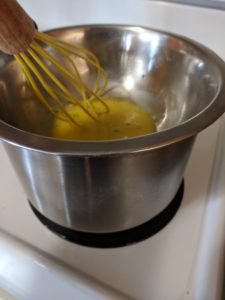
Once the egg yolk and acid mixture are set over the simmering water, it is important not to stop whisking. You don’t have to whisk vigorously but you do have to whisk constantly. The risk here is that the yolk will cook to the bottom and sides of the bowl. This will lead to a grainy textured hollandaise. Unpleasant to say the least. It’s also important that the water not be boiling as the yolks will heat too quickly and you will have scrambled eggs which does not make a good hollandaise sauce.
The egg yolks are being cooked for two reasons, to thicken them which will lead to a thicker consistency of the final sauce. The second reason is to pasteurize the egg yolks to make them safe to eat.
The egg yolks are done cooking when they are thick and reach the ribbon stage. That is when you lift the whisk out of the egg yolks and the yolk that falls back into the bowl forms almost like a ribbon and sits of the 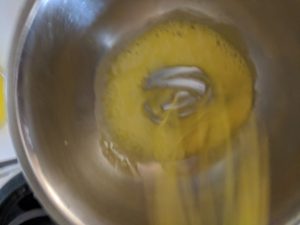
I prefer to add the butter to my hollandaise when it is off the heat which is a slightly safer method. The key to this is that the butter has to be hot.
I remove the bowl from the double boiler and a few drops at a time I start to whisk in the butter. Once those first few drops have been incorporated I whisk in a few more drops. Essentially, this process just keeps repeating until all the butter has been incorporated. You may need to add a little more lemon juice or water to your sauce to thin it out so you can add the entirety of the butter. What’s interesting, is the more butter you add the thicker your sauce will get.
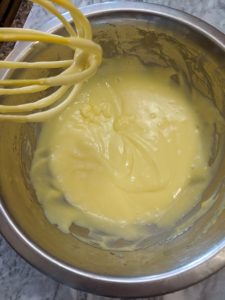
What can go wrong?
There are really only two things that can go wrong when making hollandaise sauce.
The first thing is that the egg yolks get too hot and solidify. This can occur only on the bottom and sides of the bowl. Or, if the bowl gets really hot the whole batch of egg yolks can cook. If this happens the only solution is to start again. There is no coming back from scrambled egg yolks.
To prevent the egg yolks from getting too hot make sure the bowl isn’t touching the water in the pot below. Make sure the water in the pot isn’t boiling and is actually just barely simmering. And finally, don’t stop stirring. Keep the egg yolks moving and watch closely. You want the egg yolks to coagulate but there is only a few degrees difference in temperature between slightly coagulated egg yolk and rock hard egg yolks. So watch carefully.
The second thing that can wrong is that the butter is added too quickly into the sauce and it separates. A hollandaise that has separated looks pretty disgusting. Like curdled milk. However, if this happens it isn’t the end of the world or even the end of your sauce. It can be saved.
To fix a broken sauce start with a clean bowl and a few fresh egg yolks. Put the bowl over the heat and cook the egg yolks just like you did with the ones in the split sauce. Once the egg yolks have begun to thicken start incorporating the broken sauce as though it was the butter you originally added. What I mean by that is slowly add the broken sauce a few drops at a time, whisk to incorporate and then add more. Do this until all of the broken sauce has been incorporated. Now, you can finish adding the rest of your clarified butter if needed.
In all honesty, it is kind of a pain in the ass to have to fix your sauce. This is especially true if you are hungry and just want to eat. The real solution is not to let your sauce break at all.
Ratios
For hollandaise sauce, I usually stick to 1/4 cup of clarified butter and 1-2 tsp of lemon juice for every egg yolk. To that, I may need to add 1-2 tsp of water as well. For Eggs Benedict for two use 2 egg yolks and 1/2 cup of clarified butter.
Derivatives
Béarnaise sauce –
By far the most popular hollandaise derivative is béarnaise sauce. It is a classic steak sauce and with good reason. To make this start the hollandaise the same way you normally would except instead of using lemon juice make a vinegar reduction with shallot and tarragon. The final sauce may also be garnished with fresh tarragon.
Choron –
Choron is a mixture of béarnaise sauce and tomato sauce. Commonly served on grilled or roasted meat and poultry.
Maltaise –
The addition of blood orange juice and segments makes hollandaise a Maltaise sauce. Very, very good on asparagus.
Mousseline –
Hollandaise mixed with whipped cream. A lighter version of hollandaise great on fish and asparagus.
Paloise –
Similar to béarnaise sauce except mint is used rather than tarragon. Good with lamb.
Royal –
A really old school sauce made of equal parts velouté, hollandaise, and whipped cream. Traditionally served over white meats and poached fish.
Conclusion
It is my sincere hope that if you have never made hollandaise sauce before that this post has given you the confidence to give it a shot. At the very least I hope that you now see that hollandaise is not this mystical sauce that only true masters can make.
If you have been paying attention you may have noticed that the process for making hollandaise is almost identical to making mayonnaise and even Caesar salad dressing. The only real difference is the temperature. You may also have realized the principles for making hollandaise are the same principles for making vinaigrettes as well.
The idea here is that by learning one technique you are actually learning how to make literally thousands of things whether you realize it or not. So, if you have even made a vinaigrette, you can make a hollandaise sauce. If you have ever made hollandaise sauce you can make mayonnaise. If you can make mayonnaise you can make caesar dressing. Get it? I hope so.
Next Wednesday we will be looking into the fifth and final mother sauce. I hope that you are looking forward to it as much as I am.
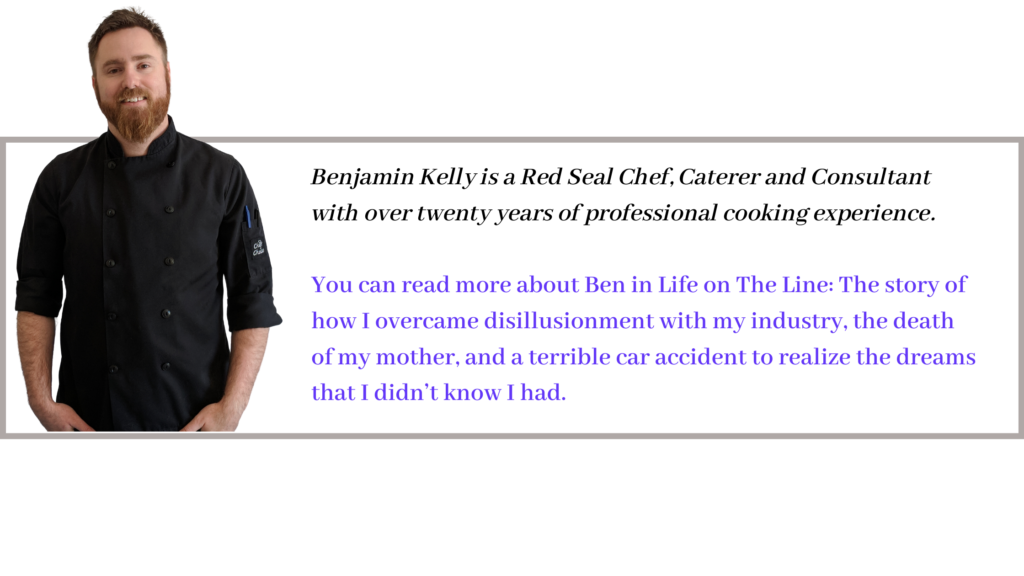

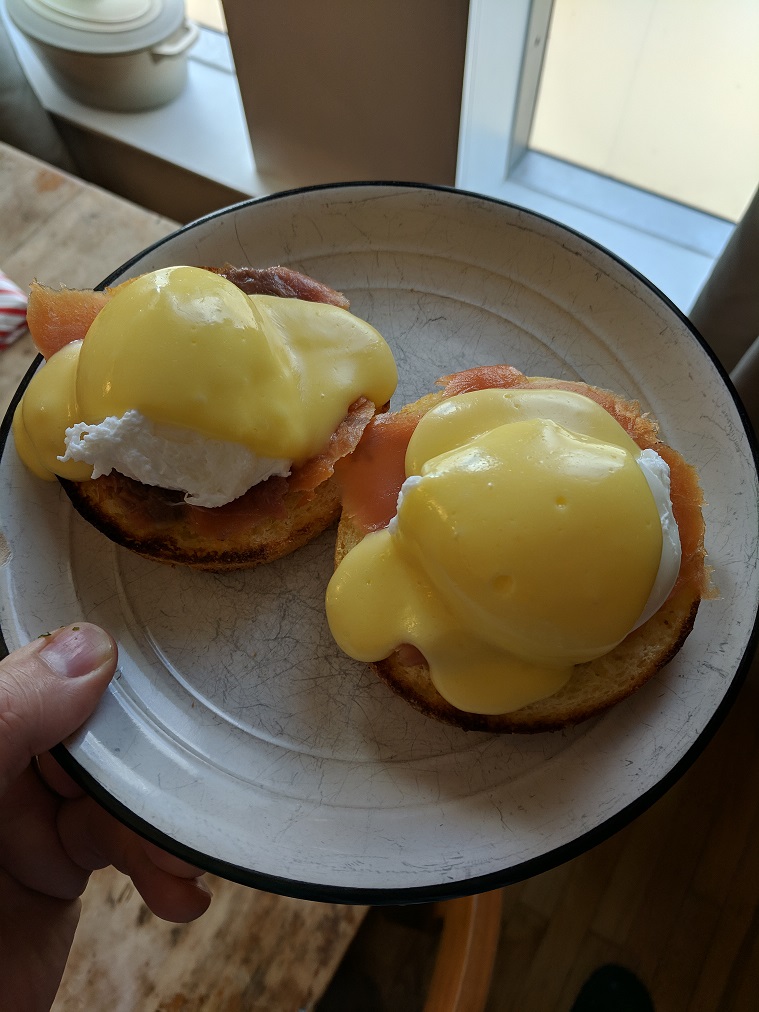
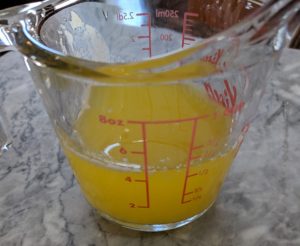 Clarified Butter
Clarified Butter
0 Comments
Trackbacks/Pingbacks